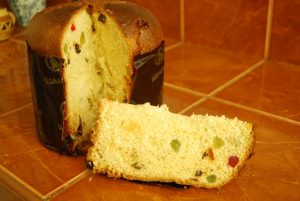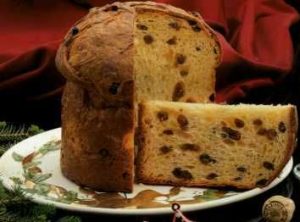Conflict over Panetones Rises

One cannot imagine Christmas in Peru with out the sweet, fruited bread called panetón. It is eaten by almost everyone at this time, often accompanied by hot chocolate, as part of the national culture. Yet at the international level, Peru’s tradition of making panetones is under attack.
The market for panetones is growing strongly in Peru. At this time of the year, the main bakers of the product, such as the iconic D’Onofrio, expand production and sales as they stock stores and markets throughout the country with their festive packages of panetones. Many other bakeries, national and local, jump into the act, baking panetones to fill the enormous and growing demand in Peru.
Peru’s panetones are not just sold in Peru, but also find there way into other countries. Peruvian stores in the United States, as well as general Latino markets, also fill with panetones from Peru, Brazil, Argentina, and so on, all places to which lots of Italians immigrated in the late nineteenth and early twentieth centuries. And the panetón is developing a market among people who are not from Latin America at the same time a similar product from Italy, the panettone is also claiming market share.
In that lies the conflict and the problem.
The connection of panetones to Italian immigrants to Latin America suggest the need to study the recent elaboration of national and international Christmas traditions in Peru and elsewhere, though that is not out task here.

Instead, we can notice that people like D’Onofrio’s founder, Antonio, D’Onofrio, an Italian immigrant, relied on an Italian recipe called the Alemagna recipe, to make his seminal and very popular product. This name refers to a competition among Milanese bakers, Motta and Alemagna, to mass produce golden fruit bread for the growing urban masses. They mark a moment of change from artisanal to industrial production of breads for celebrations such as Christmas.

More recently, multinational enterprises such as Nestle have stepped in and acquired the Italian and Peruvian producers of panetones and panettones. While Nestlé still owns D’Onofrio, they have recently sold the traditional Milanese bakeries Motta and Alemagna to the Bauli family business.
Now comes the conflict on this stage of Italian migration and mass production of industrial food in many countries.
Italy, stimulated in part by the Bauli family, is arguing that the panettone is something typically Milanese and that there is a precise recipe dependent on quality of local ingredients that are required for a golden fruited bread to be considered panettone or even panetón. They have sought the status and protection of a Denomination of Origin and recently obtained it.
In this they are defining a certain panettone as legitimate and others as “false” or imitation in order to defend market share and obtain a marketing advantage internationally, since both the Latin American and Italian breads are sold in global markets and have been sold since the end of the twentieth century as part of the expansion of global, industrial foods such as those produced by Nestlé.
Instead of an industrial product that is part of a multinational and global food enterprise, panettone is portrayed as if it were solely a regional and “artisanal” food. Italy is rejecting its sons and daughters abroad—those hoards of Italians who established themselves in Latin America from the times when both Milan and America were ruled by Spain–as well as the Swiss giant Nestlé which markets panetones D’Onofrio as Peruvian.

National and regional origin has become now part of commercial strategies for branding and marketing. This also results in faulty mythologies and histories, such as both the D’Onofrio myth and the Bauli myth.
One possible way around this challenge would be to simply argue that the panettone and the panetón are different product, simply given in the way Italian adds an additional “t” that the Spanish does not have, at the same time they insist of some essential differences in the recipes and ingredients.
Or, the giant industries along with allies in the various countrys’ governments such as Peru and Italy, can fight the issue in International forums. To the degree they succeed or fail they provide the space for national and multinational industries to sell denominated products to increasingly global audiences.
This Christmas season–which goes through the sixth of January in Peru, when Peruvians lift their tall slice of panetón to their lips, at the same time their brand is marketed abroad, they are eating and celebrating in the middle of this global struggle, built on international immigration and industrialiation.




